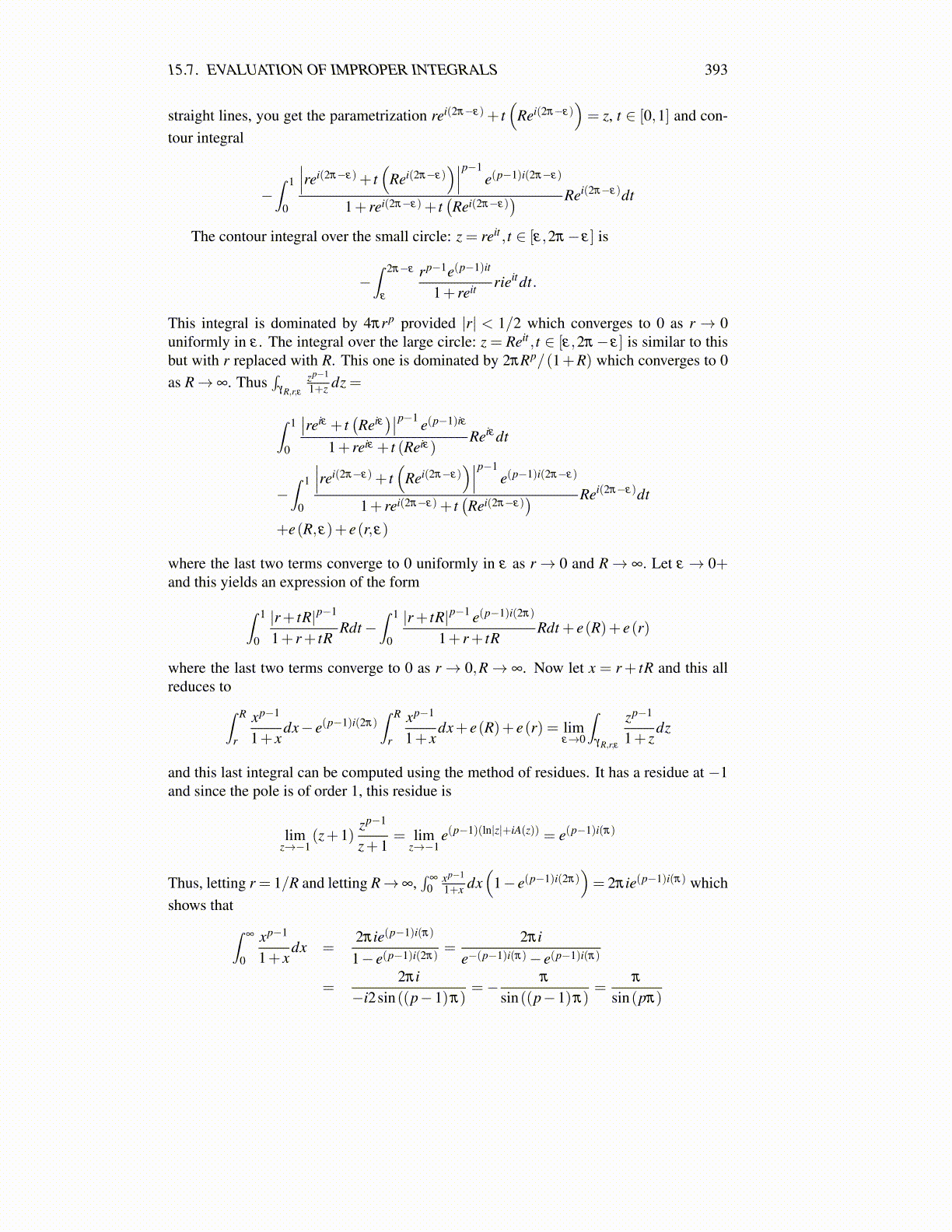
15.7. EVALUATION OF IMPROPER INTEGRALS 393
straight lines, you get the parametrization rei(2π−ε)+ t(
Rei(2π−ε))= z, t ∈ [0,1] and con-
tour integral
−∫ 1
0
∣∣∣rei(2π−ε)+ t(
Rei(2π−ε))∣∣∣p−1
e(p−1)i(2π−ε)
1+ rei(2π−ε)+ t(Rei(2π−ε)
) Rei(2π−ε)dt
The contour integral over the small circle: z = reit , t ∈ [ε,2π− ε] is
−∫ 2π−ε
ε
rp−1e(p−1)it
1+ reit rieitdt.
This integral is dominated by 4πrp provided |r| < 1/2 which converges to 0 as r → 0uniformly in ε . The integral over the large circle: z = Reit , t ∈ [ε,2π− ε] is similar to thisbut with r replaced with R. This one is dominated by 2πRp/(1+R) which converges to 0as R→ ∞. Thus
∫γR,r,ε
zp−1
1+z dz =
∫ 1
0
∣∣reiε + t(Reiε
)∣∣p−1 e(p−1)iε
1+ reiε + t (Reiε)Reiε dt
−∫ 1
0
∣∣∣rei(2π−ε)+ t(
Rei(2π−ε))∣∣∣p−1
e(p−1)i(2π−ε)
1+ rei(2π−ε)+ t(Rei(2π−ε)
) Rei(2π−ε)dt
+e(R,ε)+ e(r,ε)
where the last two terms converge to 0 uniformly in ε as r→ 0 and R→ ∞. Let ε → 0+and this yields an expression of the form
∫ 1
0
|r+ tR|p−1
1+ r+ tRRdt−
∫ 1
0
|r+ tR|p−1 e(p−1)i(2π)
1+ r+ tRRdt + e(R)+ e(r)
where the last two terms converge to 0 as r→ 0,R→ ∞. Now let x = r+ tR and this allreduces to∫ R
r
xp−1
1+ xdx− e(p−1)i(2π)
∫ R
r
xp−1
1+ xdx+ e(R)+ e(r) = lim
ε→0
∫γR,r,ε
zp−1
1+ zdz
and this last integral can be computed using the method of residues. It has a residue at −1and since the pole is of order 1, this residue is
limz→−1
(z+1)zp−1
z+1= lim
z→−1e(p−1)(ln|z|+iA(z)) = e(p−1)i(π)
Thus, letting r = 1/R and letting R→∞,∫
∞
0xp−1
1+x dx(
1− e(p−1)i(2π))= 2πie(p−1)i(π) which
shows that∫∞
0
xp−1
1+ xdx =
2πie(p−1)i(π)
1− e(p−1)i(2π)=
2πie−(p−1)i(π)− e(p−1)i(π)
=2πi
−i2sin((p−1)π)=− π
sin((p−1)π)=
π
sin(pπ)